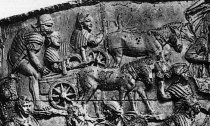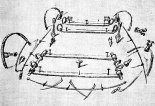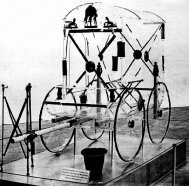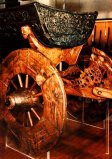
According to archaeological finds, Roman wagons and carts usually had wheels with iron bandings on the rolling surface. The iron banding was made of a seamless ring, pressed hot over the wooden felly. It was fastened to the wheel as a result of shrinking during the cooling process. This technique was the same as the one employed in the 20th Century. It requires considerable skill and precision work by both blacksmith and felly maker. It is surprising to see that this technology was lost after the end of the Roman era and was only rarely used until the 19th century.
Roman travel wagons: | |
 |
Typical find of a Roman travel wagon. Iron and bronze pieces dominate the site [5] |
 |
The reconstruction of the position of the metal parts on such a travel wagon [6] |
Even a layman understands that the iron ring protects and hardens the wheel. It saves from abrasion and reduces the rolling friction. Such a wheel lives longer and makes transport more efficient. This is so obvious that even the people who lived after the Romans were probably aware of it. The loss of iron banding in early MA can not be due to loss of knowledge but changed economic conditions:
"The European early MA is marked by metal penury. (...) Late ancient mines decayed. An insignificant iron production allowed weapon production and sword exports in the Charlemagne time. But in agriculture, for instance, only few iron devices were used. The metal penury forced a revival of mining in the 9th century." [7]
During this iron penury we lost trace of the Roman iron core horse collar too. It was replaced by the MA type collar built without any iron parts. The iron penury was so severe that even graves were robbed for iron pieces. [8]
 |
The wheels of the MA were iron-less, sturdy, heavy "block wheels". We find them first at the Oseberg Wagon of 850 AD. [9] |
In 1320 AD we have the first record of a wagon with "iron-nailed wheels" [10]. It was probably a travel wagon for female nobility. This wheels were noted by the writer as an exception and were so until modern times.
Even in the late 15th century, the army of the German Emperor Maximilian was without iron banded wheels too (see MA housebook).
German records of 1674 show none iron banded wheels even in use on long range transport. [13]
 |
In 1782 northwestern Germany we find horse carts still without iron-banded wheels. [14] |
In a peasant record of 1835, an iron-banded wheeled wagon ("Wagen mit eisenbeschlagenen Raedern") was 60% more expensive than another wagon without such. Stenkamp found records in 1715 indicating even higher price differences because of the expensive iron. [15]
This is no surprise. The main rise in iron production and the availabilty of relatively cheap iron in Central Europe came in the mid 19th century from the demands of the railways. Did the Romans regard iron-banding as more important than engineers at later times or was iron cheaper then? The extensive Roman use of iron for mule collars, hipposandals (which needed more iron than horseshoes) and for a lot of wagon parts strongly points to a lower price of Roman iron than for the whole time until ca. 1850. This is supported by Stenkamp who found differentiation in the records between wheels that were iron-banded and those that were not only until around 1840.
Is the data mentioned above valid for whole Europe or influenced by geography? Stenkamp's area of research was northwestern Germany [16]. South of his region is the Ruhr area, Germany's main iron and coal resource. Iron was cheaper than anywhere in Germany and most of Europa in this regione. The price change in England probably occurred up to 100 years earlier. In other parts of Europe like Spain and Italy, it took place not before 1900 or even later.
This indicates that in Roman times iron production was sufficient to even penetrate the consumer market to a level unreached until around 1850. In other words the civil (per capita) use of iron was unreached until the mid 19th century.
References (see Roman Traction Systems for Bibliography):
Text Content by SENECA 1999[1] Ernst Kuenzel (Ed.): Die Alamannenbeute aus dem Rhein bei Neupotz, Vol. I, Mainz 1993.
[2] C. W. Roering (1983) p.43: Find of 4 wheeled wagon, each 1.2 m diameter, with a roof girder structure of iron bands forming a shape somwhat like a covered wagen of the 19th c. American West. This find is unparralelled. Mentioned in 1963. Site in Scafati (Regio of Salerno, Italy). No final publication available to Roering, no response on a letter by Roering. Only Ref.: P.C.Sestieri, Fasti Arch. 15, 1963, 306 No. 4513.
[3] Maiuri, Amadeo: La Casa del Menandro, Rome 1932, Vol 1. p.194.
[4] Maiuri, p. 193.
[5] from C. W. Roering (1983), after Venedikov,(1960).
[6] from C. W. Roering (1983).
[7] Schaefer, H. (Ed.): Ploetz, Wirtschaftsgeschichte der deutschsprachigen Laender, Freiburg 1989, p.15.
[8] W. Timpel: Das altthueringische Wagengrab von Erfurt-Gispersleben. Alt-Thueringen 17, 1980, 181-240; Wamser, Ludwig: Eine thueringisch-fraenkische Adels- und Gefolgschaftsgrablege des 6./7. Jahrhunderts bei Zeuzleben, Wuerzburg 1984; Rettner, Arno: Das fruehmittelalterliche Graeberfeld von Zeuzleben, Muenchen, 1997.
[9] Achse, Rad und Wagen.
[10] Aubin/Zorn p. 128.
[11] Achse, Rad und Wagen.
[12] Georg J. Kugler, in: Achse p.236. Kugler notes that the use of wooden axles was still "a matter of course" ("selbstverstaendlich") in an economic-technological encyclopaedia of J. G. Kruentz, Berlin 1794, p. 279.
[13] Stenkamp, Hermann Josef: Karren und Wagen, 1997, p. 83.
[14] Stenkamp.
[15] Stenkamp, Hermann Josef: Karren und Wagen, 1997, p. 82.
[16] .. and part of the Netherlands. Niederrhein, Westmuensterland, Achterhoek and Limers.